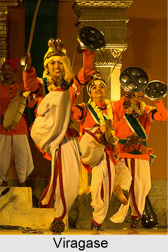 Virgase is one of the most prominent folk performances in Karnataka, which is connected with the Saiva and Virasaiva religious sects. Scholars believe that the older Saiva sects, with an affinity to tantric practices, nurtured many performatory genres. Later, when the Virasaivas appeared in the twelfth century, they adapted those genres to serve as propagandist media for the new movement. Most probably, Viragase is one such form, its name derived from its costume. The costume can be explained as short dhoti worn in the heroic, valorous style, besides a kurta, turban, waistband, and ornaments.
Virgase is one of the most prominent folk performances in Karnataka, which is connected with the Saiva and Virasaiva religious sects. Scholars believe that the older Saiva sects, with an affinity to tantric practices, nurtured many performatory genres. Later, when the Virasaivas appeared in the twelfth century, they adapted those genres to serve as propagandist media for the new movement. Most probably, Viragase is one such form, its name derived from its costume. The costume can be explained as short dhoti worn in the heroic, valorous style, besides a kurta, turban, waistband, and ornaments.
Today, Viragase is normally seen at village fairs and community occasions like marriages. The performances often take the shape of offerings to God by the devotees. It consist of vigorous song and dance combined with storytelling by a group of eight to twelve people, including singers, drummers, cymbalists, and sword dancers. The narrator intervenes to relate the story in epigrammatic couplets, and the dancers join him as a chorus. Sometimes there are multiple narrators, each picking up the story-strand in turn. The themes revolve around the demigod Virabhadra, created by the wrathful Siva to combat Daksha. With the entry of Virabhadra the narrative climax reaches the zenith as the subsequent tale eulogizes his various heroic acts. Each such episode is brief. As a result, Viragase is oriented more to creating an atmosphere of devotion than communicating a narrative. This can be said as one main reason why it has become more popular today as a social celebration than a dramatic performance.
This article is a stub. You can enrich by adding more information to it. Send your Write Up to content@indianetzone.com




















